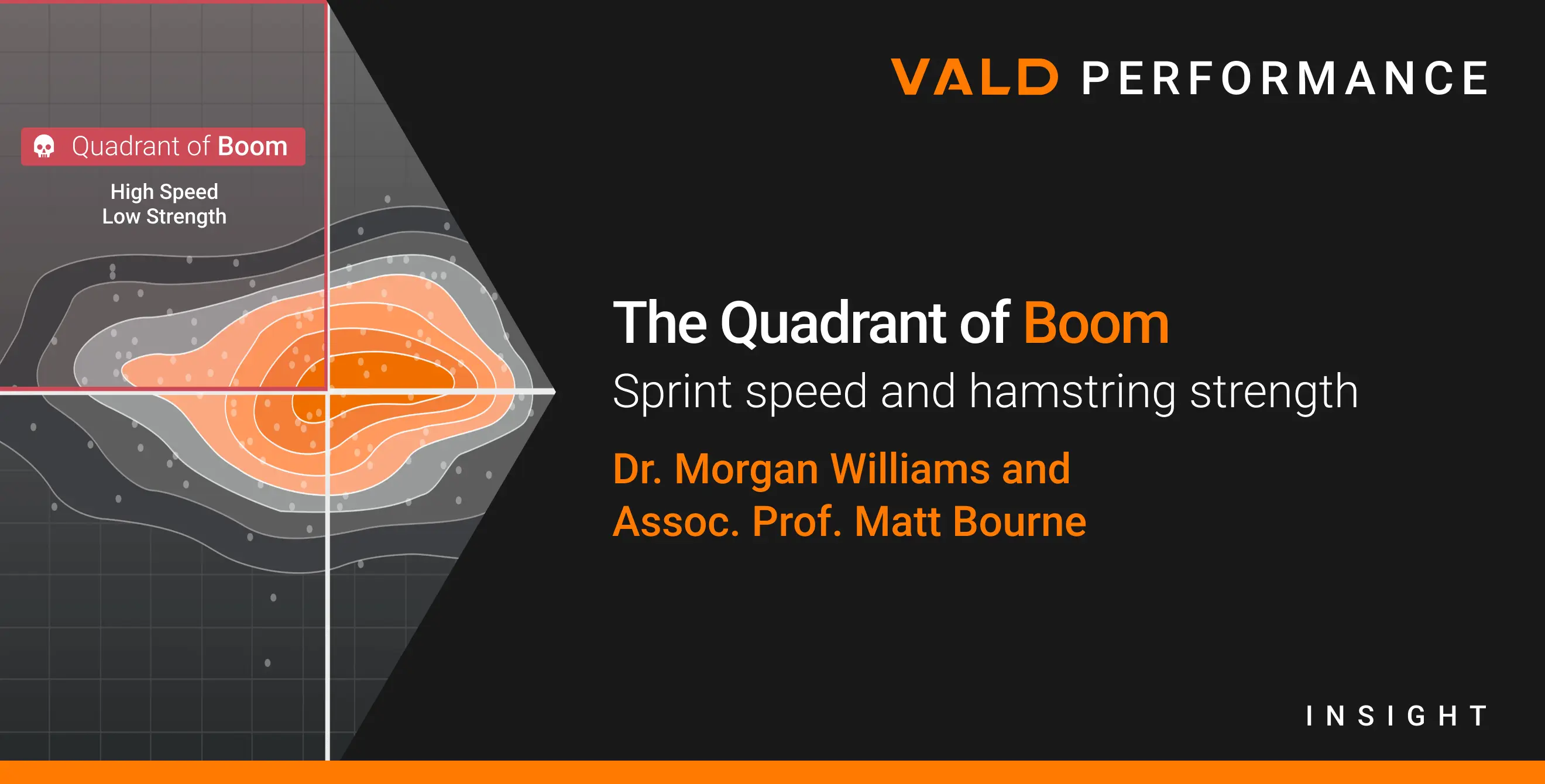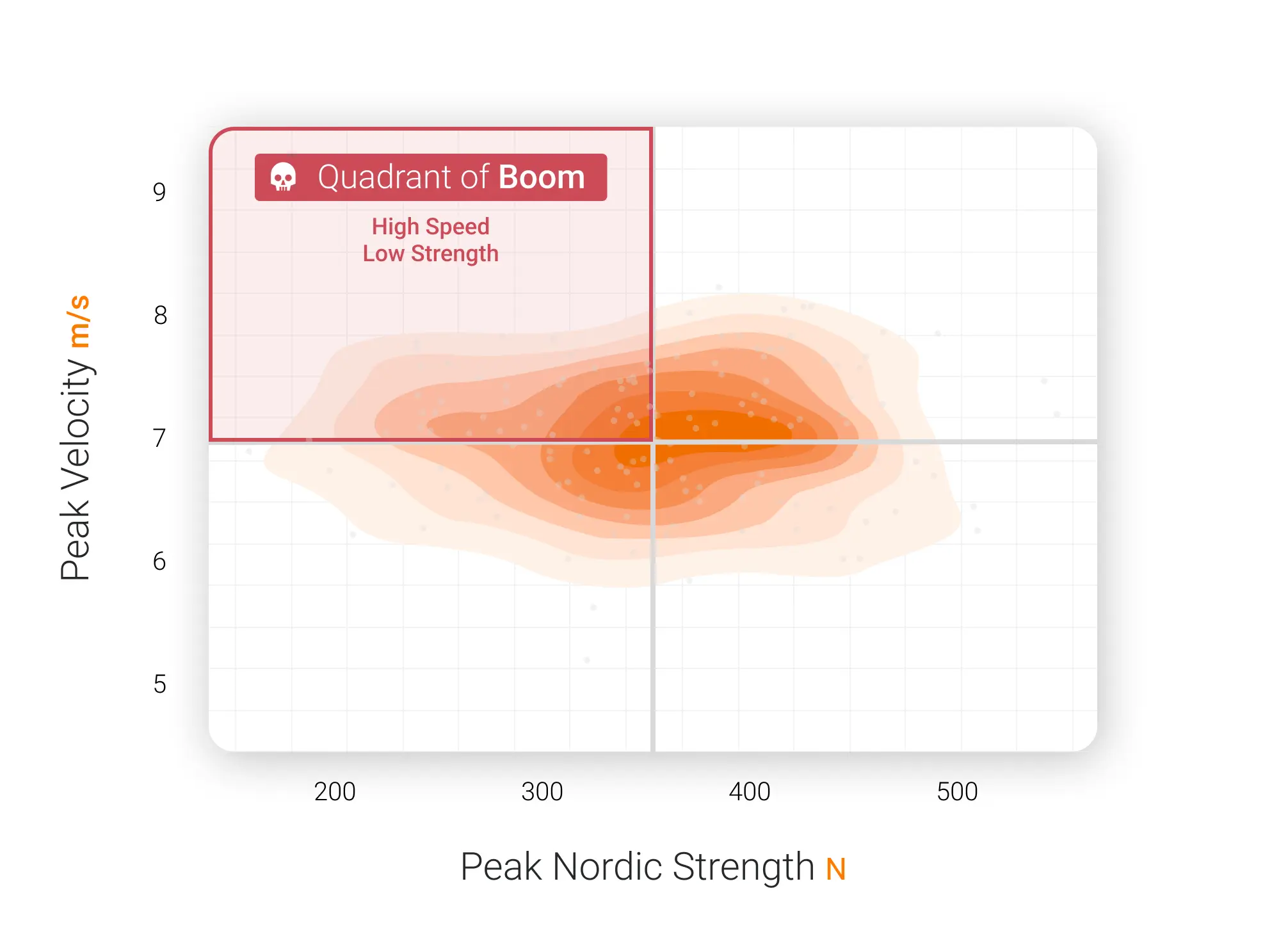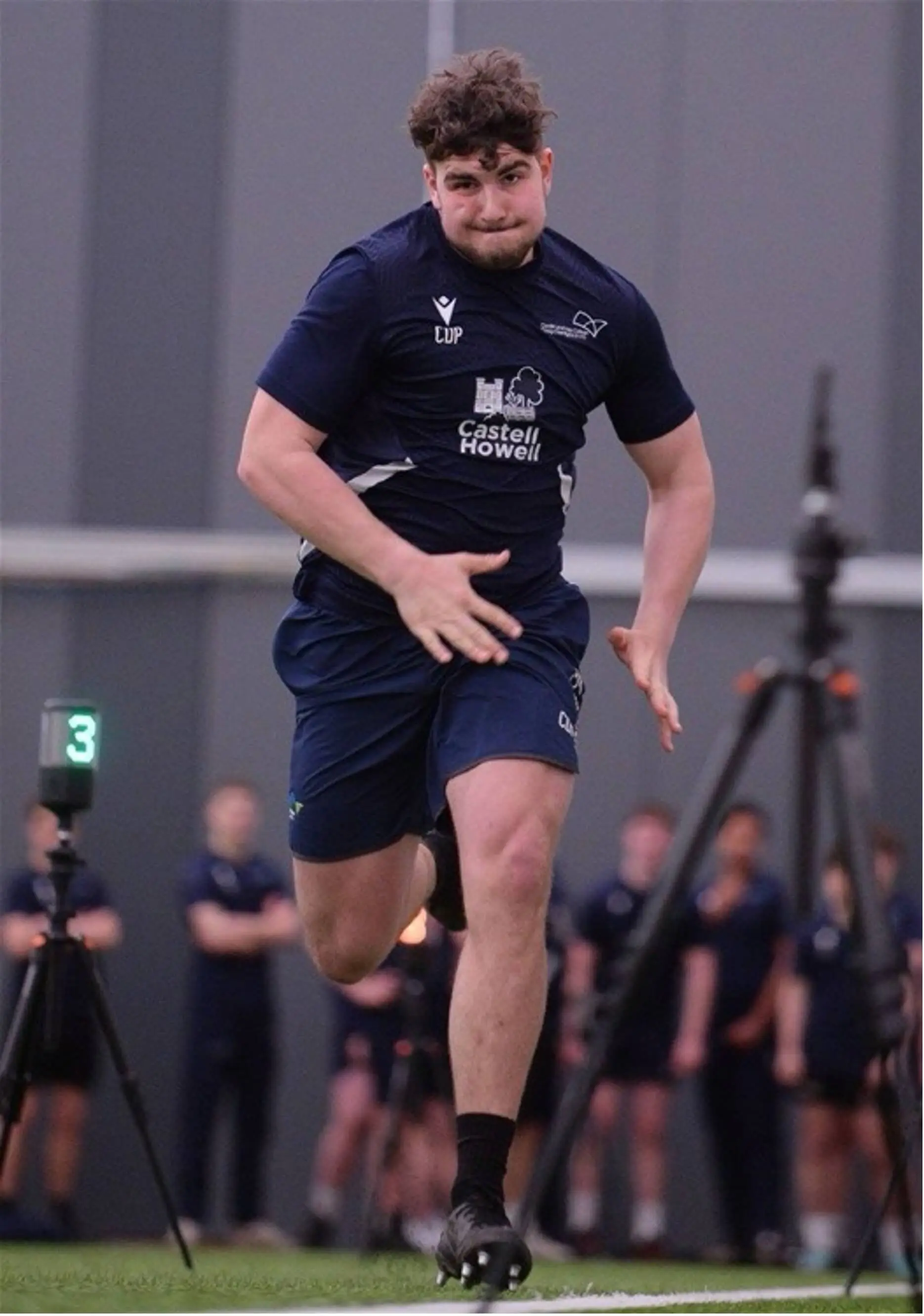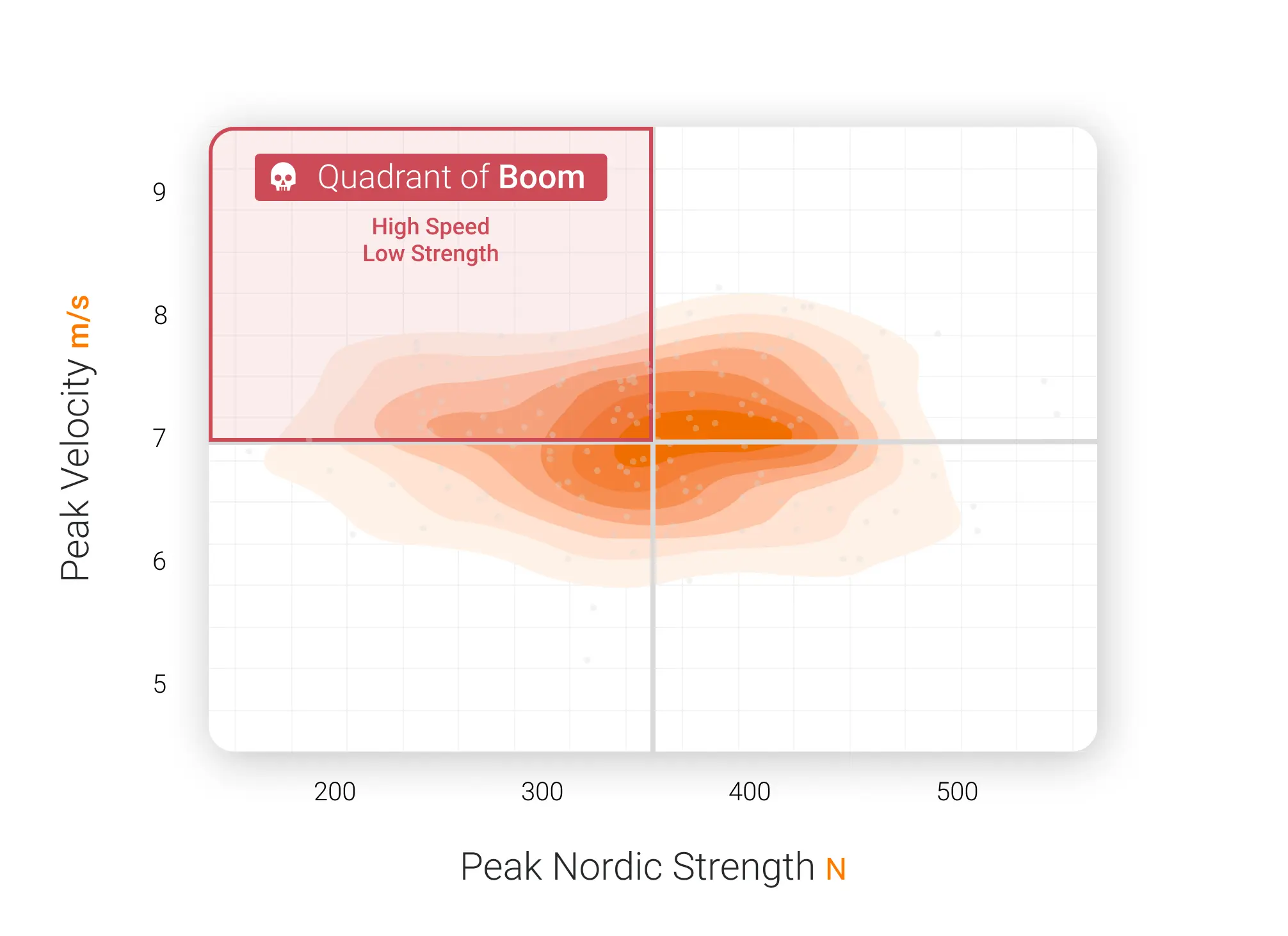The Quadrant of Boom: Sprint speed and hamstring strength
Available in:
EN
About the Authors
Dr. Morgan Williams is a Data Scientist at VALD and Adjunct Associate Professor at Griffith University’s School of Health Sciences and Social Work. As part of the VALD Data Science Team, Dr. Williams uncovers new insights into VALD data and identifies how they can be used to enhance practice.
Associate Professor Matt Bourne is a Principal Research Fellow at Griffith University and spearheads the Precision Athlete research program at the Australian Centre for Precision Health and Technology. He leads a multidisciplinary research team focused on developing and applying innovative technologies to optimize performance and predict, prevent and recover from sports injuries.
The Quadrant of Boom is a new framework we propose to plot sprint speed against eccentric hamstring strength in order to assess an athlete’s readiness to perform and potential risk of hamstring strain injury. Using SmartSpeed and NordBord outcome measures, we will explore how this simple, data-informed approach can help identify outliers, understand interactions between data and guide performance and injury prevention decision-making.

Sprinting and the hamstrings have a love-hate relationship: sprinting can either break them or make them stronger. The high levels of mechanical strain, muscle force and negative musculotendon work in sprinting create the “perfect storm” for hamstring injuries. However, eccentric hamstring training – when done correctly – can significantly reduce the risk of these injuries while improving strength and performance.
Eccentric conditioning focuses on strengthening the hamstrings while they “actively lengthen,” which is critical when running at high speeds. This type of training enhances the ability of the hamstrings to absorb energy and decelerate the leg during sprinting, making them more damage-resistant and reducing the likelihood of strain injury.
…sprint and eccentric hamstring training can lead to positive adaptations in hamstring structure and function, boosting performance and reducing injury risk.
When implemented appropriately, sprint and eccentric hamstring training can lead to positive adaptations in hamstring structure and function, boosting performance and reducing injury risk. But where do you start? How do you know what is necessary and effective?
The key to effective training is measurement: “If you aren’t measuring, you’re guessing.”
Objective data from testing and monitoring can help inform the development of targeted training programs that minimize injury risk and maximize performance.
The objective of this blog is to start a conversation around sprint and eccentric hamstring strength training, with a focus on both performance enhancement and injury risk reduction. It introduces the concept of the “Quadrant of Boom,” a framework that combines two outcome measures from the SmartSpeed Timing Gate System and NordBord Hamstring Testing System to inform practitioners’ training approach.
Hamstring Function During Sprinting
Strong hamstrings are critical for running fast. During sprinting, they primarily act as “brakes,” contracting eccentrically to decelerate the forward swinging leg. As running speed increases, the terminal swing phase shortens, increasing the angular velocity at both the hip and knee (Agre, 1985). This requires the hamstrings to generate more torque.
Greater eccentric hamstring strength can improve sprint performance by increasing both stride rate and stride length (Bourne et al., 2020). On the flip side, weak hamstrings may struggle to generate sufficient torque at longer lengths, potentially increasing the risk of strain injury.
Greater eccentric hamstring strength can improve sprint performance by increasing both stride rate and stride length.
Objective Monitoring of Strength and Speed
Combining measures of eccentric hamstring strength and sprint capacities can be a good starting point to evaluate your athlete's readiness for the demands of their chosen activity. It can be achieved simply using a scatter plot of the outcomes obtained from NordBord and SmartSpeed tests.
Combining measures of eccentric hamstring strength and sprint capacities can…evaluate your athlete’s readiness…
Evidence for our concept that links sprinting speed and eccentric hamstring strength to both performance and injury risk can be pieced together from observations in the field and existing literature. Below is a summary of the important features:
1. Eccentric Hamstring Strength and Sprint Performance
Elite sprinters are faster and have greater eccentric hamstring strength than recreationally active individuals (Lazarczuk, 2024). Eccentric hamstring strength during the Nordic hamstring exercise is strongly correlated with sprint acceleration performance in youth footballers (Markovic et al., 2020).
Eccentric hamstring strength during the Nordic hamstring exercise is strongly correlated with sprint acceleration performance in youth footballers.
Further, 10 weeks of training with the Nordic hamstring exercise significantly improves eccentric hamstring strength and sprint performance in amateur footballers (Ishøi et al., 2018). Several additional studies (e.g., Krommes et al., 2017) have revealed similar gains in short-distance sprint performance after 7-10 weeks of eccentric Nordic training, flywheel leg curls or a mix of free-weight hamstring exercises.
Interestingly, Freeman et al. (2019) found that four weeks of sprint training improved maximal speed and eccentric hamstring strength (measured using SmartSpeed and NordBord).
One of the key benefits of eccentrically strong hamstrings is their ability to influence stride rate and stride length. Stride rate refers to the number of steps you take per minute, and stronger eccentric hamstrings theoretically allow for quicker deceleration of the lower leg during the swing phase, thus increasing stride rate.
On the other hand, stride length is the distance covered with each stride. Greater eccentric hamstring strength contributes to more powerful hip extensor moments during ground contact, potentially increasing stride length.
In support, eccentric hamstring strength and lateral hamstring electromyographical activity during the late-swing phase of maximal sprinting explained half (r² = 0.49) of the horizontal ground reaction force generated during sprints (Morin et al., 2015), which is a key factor influencing maximal sprint acceleration performance.
2. Eccentric Hamstring Strength and Injury Risk
Eccentric hamstring training is highly effective in preventing hamstring strain injuries. Randomized controlled trials show that eccentric conditioning reduces the risk of hamstring strains by 70% when athletes are compliant (Goode et al., 2015). A meta-analysis of 8,459 athletes also found that injury prevention programs that include the Nordic hamstring exercise cut the risk of hamstring injury by half (van Dyk et al., 2019).
…eccentric conditioning reduces the risk of hamstring strains by 70%…
There are several potential reasons why eccentric training reduces the risk of hamstring injury:
- Eccentric conditioning shifts the force-length relationship to the right, allowing the hamstrings to generate more torque and absorb more negative energy at long muscle lengths (Brockett et al., 2001).
- Eccentric training increases the fascicle length of the biceps femoris long head, making the muscle less prone to damage during high-force eccentric contractions (Bourne et al., 2017; Andrews et al., 2025).
- Short-term training promotes rapid improvements in eccentric knee flexor strength. Mixed evidence suggests that higher levels of eccentric knee flexor strength may moderate the risk of hamstring injury, particularly in older or previously injured athletes (e.g., Timmins., 2016; Opar et al., 2021).
- Eccentrically strong hamstrings may help balance active and passive force-generating structures, lowering the risk of injury caused by excessive stretch during the late swing phase of sprinting.
The proposed concept is about the outcomes of two field-based tests to support the athlete in achieving their training goals. In our opinion, it is a good place to start. It is based on the (unproven) expectation that if an athlete can sprint fast, their hamstrings should be eccentrically strong enough to reduce injury risk.
However, it is important to remember that hamstring strain injury is “multifactorial” in nature; strength and speed are only two of many factors that might influence the risk of injury. Use your experience and knowledge to interpret the results to get a more in-depth understanding of what is needed and how to achieve it. Build a deterministic model and profile your athlete to identify strengths and weaknesses and inform the training goals.
…it is important to remember that hamstring strain injury is “multifactorial” in nature; strength and speed are only two of many factors that might influence the risk of injury.
What if the balance between sprint speed and eccentric hamstring strength is or becomes disrupted or misaligned?
Based on the Quadrant of Boom concept, it is fair to expect that if you sprint fast your hamstrings should be eccentrically strong. Assessing sprint performance and eccentric hamstring strength by a simple plot could be useful to flag those athletes who are outliers and deviate away from the expected findings for whatever reason.
A limitation to using this visualization of data is that we are assuming a possible link between running fast with low hamstring strength and increased injury risk. However, it is important to acknowledge that evidence to support this connection at a population level is limited, and many other factors will contribute. This is a work in progress and an expanded list of measures will follow in a future blog.
Introducing the Quadrant of Boom
SmartSpeed and NordBord can be used to assess sprinting speed and eccentric hamstring strength in the field or clinic.
Below is an example using a dataset collected as part of the Welsh Rugby Union (WRU) Schools and Colleges League project supported by the University of South Wales. The dataset includes SmartSpeed and NordBord data obtained from 155 male school-aged Rugby Union players tested during preseason.

An athlete from the WRU Schools and Colleges League project completing the 40m sprint test using SmartSpeed.
SmartSpeed timing gates were set up at 0, 10, 20, 30 and 40m. The athletes performed 40m maximal sprint efforts from a standing start, and peak velocity was recorded as the highest velocity from the four 10m intervals. After the sprint testing, mean peak force output from the Nordic test was obtained using the protocol guidelines available at VALD’s Knowledge Base.
The units of measurement for the test outcomes can then be plotted (see Figure below). Compared to standardized units (i.e., z-scores), keeping to units of measurement has advantages for interpretation and communication of findings since they are familiar to everyone involved. Reference lines defining the quadrant on the x and y axis can be added to represent the population mean for speed and strength. A more advanced approach could be to use Cluster Analysis to classify groups by speed and eccentric hamstring strength data.

The Quadrant of Boom can be found in the top left corner of the plot, representing athletes with the capacity to run fast but with low eccentric hamstring strength. While (in theory) it could be speculated that being in this quadrant could increase the risk of injury, this alone is not cause for concern, as exposure to high-risk scenarios is still necessary for injury to occur. It is possibly why more injuries happen in competition than in training.
The Quadrant of Boom…[represents] athletes with the capacity to run fast but with low eccentric hamstring strength.
In training, athletes typically have more control over intensity and can manage their exposure to high-speed efforts. However, in competition, increased arousal and external pressure can push athletes beyond their usual limits, elevating the risk of a hamstring strain injury.
This could also explain why new and less experienced players in team sports are more prone to injuries in preseason. Eager to prove their worth, they often lack the experience to know when to hold back and safeguard themselves.
Interpreting the Quadrant of Boom
Now that the sprint speed and hamstring strength quadrant have been specified, the next step is to interpret the findings:
Top Right Quadrant: Strong and fast. This is the ideal quadrant. It is consistent with the concept proposed being fast will make you strong, and being strong will make you fast. Here, athletes are better equipped to tolerate high levels of stress and strain in sprinting and (hopefully) remain free of hamstring strain injury. Unfortunately, it is likely to be more complicated than that, and we will explore this further in a subsequent blog.
Top Left Quadrant: The Quadrant of Boom – not strong, but fast. This is a quadrant of concern. It flags the need to follow up and explore why the athlete is fast but lacks eccentric strength. Could this be due to inadequate exposure to eccentric conditioning, previous injury, time away from sport, neuro-inhibition, technique, avoidance of eccentric forces via compensatory movements or the need to retest whether the Nordic test was a true reflection of eccentric hamstring strength?
Bottom Right Quadrant: Strong, but not fast. This is a quadrant where strength has most likely been developed from activities other than sprinting.
Bottom Left Quadrant: Neither strong nor fast. Individuals in this quadrant would be typically identified at risk of hamstring strain injury based on strength measures alone (e.g., Timmins et al., 2016). This is the least populated quadrant, and we regard this as the place to inspire a combination of speed and strength training. However, be cautious of rapid gains, as athletes may need time to adjust and recalibrate.
Summary
The “Quadrant of Boom” is a framework that combines sprint and eccentric hamstring strength data to assess an athlete’s readiness to perform and risk of injury. By leveraging modern, accessible tools like SmartSpeed and NordBord, coaches and clinicians can rapidly and reliably evaluate athletes’ strength and sprint capacities, identifying areas for improvement and guiding the design of targeted training programs.
This emphasizes the importance of a data-informed approach to training, aiming to optimize performance while minimizing injury risk through a better understanding of individual athlete profiles.
If you would like to learn more about how NordBord and SmartSpeed data can be used to enhance your practice, please reach out here.
References
- Agre, J.C. (1985). Hamstring Injuries. Sports Medicine, 2, 21–33. https://doi.org/10.2165/00007256-198502010-00003
- Andrews, M. H., Pai, A., Gurchiek, R. D., Pincheira, P. A., Chaudhari, A. S., Hodges, P. W., Lichtwark, G. A., & Delp, S. L. (2025). Multiscale hamstring muscle adaptations following 9 weeks of eccentric training. Journal of Sport and Health Science, 14, 100996. https://doi.org/10.1016/j.jshs.2024.100996
- Bourne, M. N., Duhig, S. J., Timmins, R. G., Williams, M. D., Opar, D. A., Al Najjar, A., Graham, K. K., & Shield, A. J. (2017). Impact of the Nordic hamstring and hip extension exercises on hamstring architecture and morphology: implications for injury prevention. British Journal of Sports Medicine, 51(5), 469–477. https://doi.org/10.1136/bjsports-2016-096130
- Bourne, M., Schuermans, J., Witvrouw, E., Aagaard, P., & Shield, A. (2020). Neuromuscular factors related to hamstring muscle function, performance and injury. In: Thorborg, K., Opar, D., Shield, A. (eds) Prevention and Rehabilitation of Hamstring Injuries. Springer, Cham. https://doi.org/10.1007/978-3-030-31638-9_5
- Brockett, C. L., Morgan, D. L., & Proske, U. W. E. (2001). Human hamstring muscles adapt to eccentric exercise by changing optimum length. Medicine & Science in Sports & Exercise, 33(5), 783–790. https://doi.org/10.1097/00005768-200105000-00017
- Freeman, B. W., Young, W. B., Talpey, S. W., Smyth, A. M., Pane, C. L., & Carlon, T. A. (2019). The effects of sprint training and the Nordic hamstring exercise on eccentric hamstring strength and sprint performance in adolescent athletes. Journal of Sports Medicine & Physical Fitness, 59(7), 1119–1125. https://doi.org/10.23736/s0022-4707.18.08703-0
- Goode, A. P., Reiman, M. P., Harris, L., DeLisa, L., Kauffman, A., Beltramo, D., Poole, C., Ledbetter, L., & Taylor, A. B. (2015). Eccentric training for prevention of hamstring injuries may depend on intervention compliance: A systematic review and meta-analysis. British Journal of Sports Medicine, 49(6), 349–356. https://doi.org/10.1136/bjsports-2014-093466
- Ishøi, L., Hölmich, P., Aagaard, P., Thorborg, K., Bandholm, T., & Serner, A. (2018). Effects of the Nordic Hamstring exercise on sprint capacity in male football players: A randomized controlled trial. Journal of Sports Sciences, 36(14), 1663–1672. https://doi.org/10.1080/02640414.2017.1409609
- Krommes, K., Petersen, J., Nielsen, M. B., Aagaard, P., Hölmich, P., & Thorborg, K. (2017). Sprint and jump performance in elite male soccer players following a 10-week Nordic Hamstring exercise Protocol: a randomised pilot study. BMC Research Notes, 10, 1–6. https://doi.org/10.1186/s13104-017-2986-x
- Timmins, R. G., Bourne, M. N., Shield, A. J., Williams, M. D., Lorenzen, C., & Opar, D. A. (2016). Short biceps femoris fascicles and eccentric knee flexor weakness increase the risk of hamstring injury in elite football (soccer): A prospective cohort study. British Journal of Sports Medicine, 50(24), 1524–1535. https://doi.org/10.1136/bjsports-2015-095362
- Lazarczuk, S. L. (2024). Adaptation of hamstring muscle-tendon geometry to injury and training [Doctoral dissertation, Griffith University]. Griffith Theses https://hdl.handle.net/10072/434225
- Markovic, G., Sarabon, N., Boban, F., Zoric, I., Jelcic, M., Sos, K., & Scappaticci, M. (2020). Nordic hamstring strength of highly trained youth football players and its relation to sprint performance. The Journal of Strength & Conditioning Research, 34(3), 800–807. https://doi.org/10.1519/JSC.0000000000002800
- Morin, J. B., Gimenez, P., Edouard, P., Arnal, P., Jiménez-Reyes, P., Samozino, P., Brughelli, M., & Mendiguchia, J. (2015). Sprint acceleration mechanics: the major role of hamstrings in horizontal force production. Frontiers in Physiology, 6, 404. https://doi.org/10.3389/fphys.2015.00404
- Opar, D. A., Ruddy, J. D., Williams, M. D., Maniar, N., Hickey, J., Bourne, M. N., Matthew, N., Pizzari, T., & Timmins, R. G. (2021). Screening hamstring injury risk factors multiple times in a season does not improve the identification of future injury risk. Medicine & Science in Sports & Exercise, 54(2), 321–329. https://doi.org/10.1249/mss.0000000000002782
- Van Dyk, N., Behan, F. P., & Whiteley, R. (2019). Including the Nordic hamstring exercise in injury prevention programmes halves the rate of hamstring injuries: A systematic review and meta-analysis of 8459 athletes. British Journal of Sports Medicine, 53(21), 1362–1370. https://doi.org/10.1136/bjsports-2018-100045
